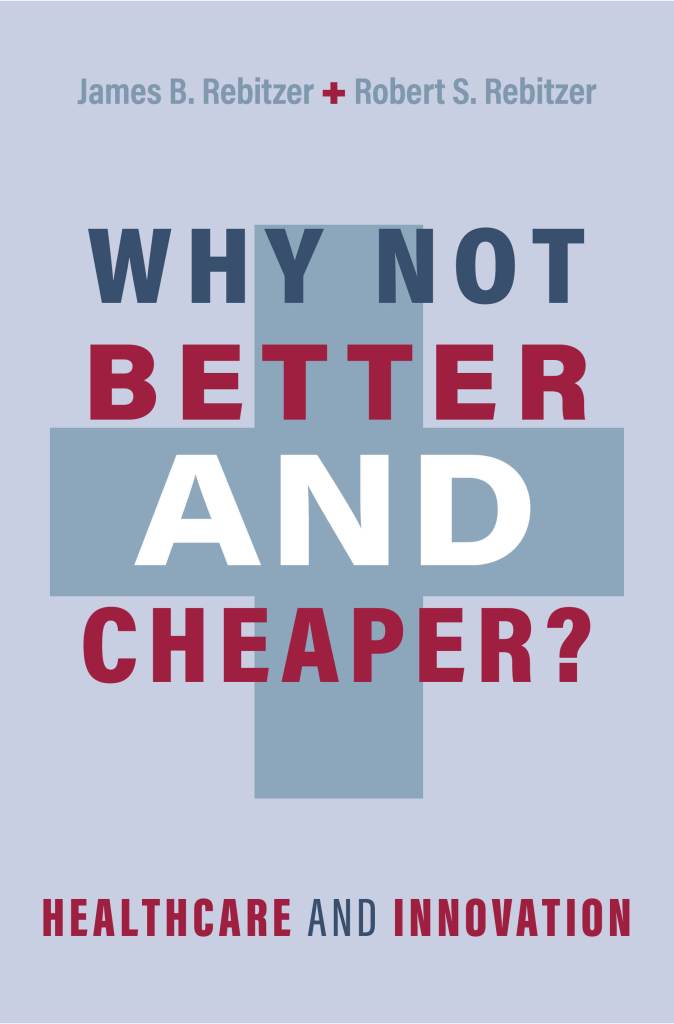Robert Rebitzer: How to overcome the disruptive forces that can impede high-value innovation

In the 1980s, two valuable innovations, laparoscopic gallbladder surgery and electronic health records (EHRs), came to market. The former became widely adopted in about three years. The latter took three decades and billions of dollars in federal subsidies.
The reasons behind the differing uptakes of health innovation are among the topics in the book Why not better and cheaper? (Oxford University Press, June 2023), written by industry analysts and twin brothers James B. and Robert S. Rebitzer about their observations of health system action and inaction. James Rebitzer is the Peter and Deborah Wexler Professor at Boston University’s Questrom School of Business. Robert Rebitzer is a national adviser at the consulting firm Manatt Health.
“The book we wrote has a very simple story,” Robert Rebitzer said. “Sometimes it’s too easy for healthcare to adopt low-value innovations and too hard [for it to] adopt high-value innovation. There are three reasons: incentives, social norms and the way competition works or sometimes fails to work to promote innovation in healthcare markets.”

As James Rebitzer explained in a January 2024 Hopkins Business of Health Initiative webinar, in the case of gallbladder surgery, “The physicians were essentially doing what they were doing anyways, just in a better way.”
Although the new surgical method involved large investments in equipment and training, it did not disrupt the business model of hospitals or surgeons, so the cost of switching over to the new method was comparatively low.
By contrast, EHRs were far more disruptive. Physicians felt their professional lives were changed, dominated by data-entry tasks. Every business process — from scheduling to patient interactions — was altered in some way, making it very disruptive for them to move to EHRs. And in such circumstances, the higher the switchover disruptions (a term commonly used by economists), the lower the incentives to adopt new technology, even if the technology is very valuable.
In a recent interview, Robert Rebitzer discussed the challenge posed by switchover disruptions and their effect on innovation.
Q: Talk to us about how switchover disruption fits into healthcare.
Robert Rebitzer: Healthcare is full of what we call “missing innovations” — good ideas that never go beyond promising pilot tests or, like EHRs, are adopted so slowly that their progress is measured in decades, even though other industries were adopting digital solutions very rapidly. Switchover disruptions are among the reasons for these missing innovations.

Healthcare delivery is mostly dominated today by local or regional systems that don’t face a lot of competition. The same is true for health insurance. These firms have a low incentive to adopt innovations that disrupt the profitable status quo. Why rock the boat? They may be willing to try a pilot test, but they will be generally unwilling to grab the idea and run with it because they face little threat that competitors will beat them to it.
The exception to that is when the entrenched incumbent’s core business model is under direct threat. In those circumstances, they have a very powerful incentive to grab new technologies.
Q: What can CFOs do to address the challenge posed by switchover disruptions?
Rebitzer: When evaluating new technologies, CFOs should look beyond the features and functions, the bells and whistles, and examine the incentives for adoption. Sometimes the way a new technology is framed can reduce switchover disruptions.
AI solutions, for example, can be positioned as a substitute or replacement for the skills of highly trained physicians or other providers of care. With that framing, resistance will likely be high and the incentives for adoption will be low. However, if AI is seen as a tool to help physicians practice medicine the way they’d like — for example by lowering the burden of paperwork and administration or improving patient outcomes — switchover disruptions will be lower and the incentives for adoption will be higher.
Q: How can health systems become more welcoming of transformative innovations?
Rebitzer: Health systems have been very innovative in recent decades. However, much of their innovative energy has been directed toward increasing their bargaining position vis-a-vis powerful health insurance companies. In other words, the innovation has been directed to keeping reimbursement high rather than delivering greater value to patients and society. I think the government has a role to play here to keep healthcare delivery and insurance markets more competitive. Concentrated market power can be a drag on innovation. But health systems also have a secret weapon that they can use to advance valuable innovation: the professional values of physicians and other providers.
Q: How does value play a role in innovation in healthcare?
Rebitzer: Consider the example of palliative care. When Diane Meier, MD, and her colleagues catalyzed the development of the palliative care model in the 1990s, they did so in the near absence of financial incentives.[1] They were developing a way to deliver care consistent with the highest value of their profession. When Bruce Leff, MD, and his colleagues at Johns Hopkins Medicine introduced the hospital-at-home model in the United States, they were responding to patient needs, not financial incentives. Professional and social norms can also be a spur to innovation.b In focusing on the roles of incentives and markets in innovation, we should not forget that fact.
Footnotes
a. See The Robert Wood Johnson Foundation, Palliative Care: Transforming the care of serious illness, Meier, D.E., Isaacs, S.L., and Hughes, R.G., editors, 2010.
b. See Arnold, C., “Home, sweet hospital,” Hopkins Medicine, Oct. 4, 2021.





